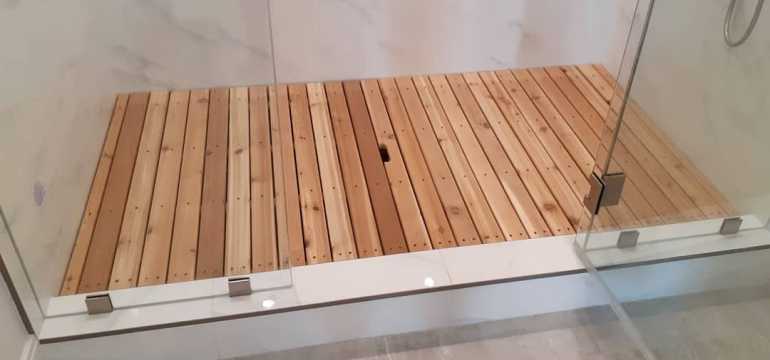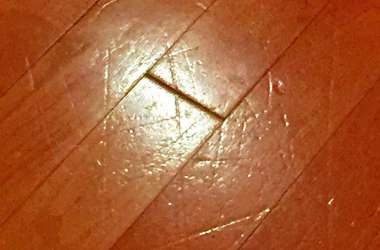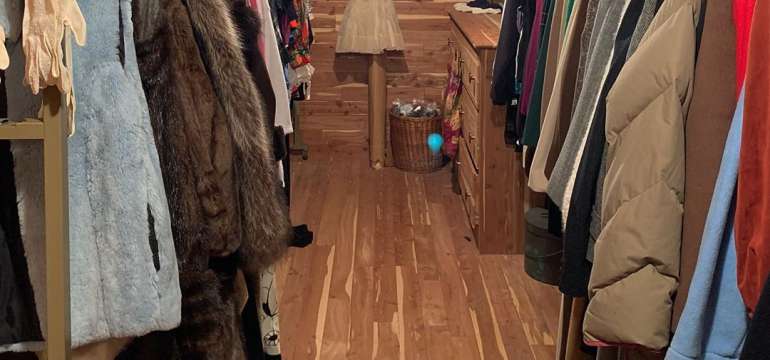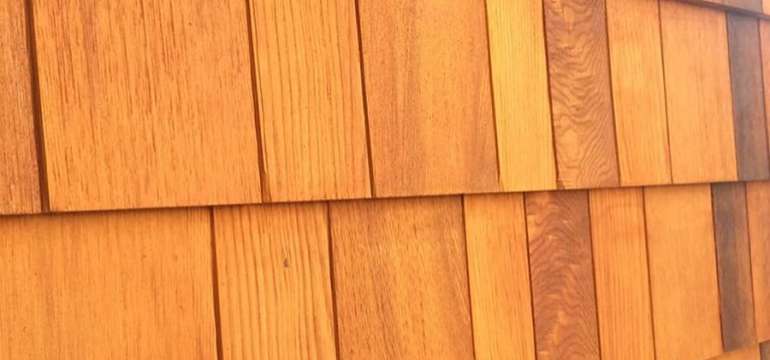When you select the perfect wood floors for your home, you are making an investment into that property for years to come. Many experts promote the benefits and durability of hardwood species like red oak and hickory, but softwood could be a better choice for your specific home. Understanding the difference between hardwood flooring and softwood flooring is important if you want to know whether cedar flooring is the best choice for you.
If you’ve been considering cedar wood flooring for your home, here are the facts you should know before you begin.
Why choose cedar flooring?
Many homeowners allow salespeople to persuade them that they really need durable hardwood floors in their homes. While this may be true for high traffic spaces like a foyer or a great room, other areas might not need this same durability. Softwood species like cedar and southern yellow pine could be the ideal addition to a guest room, closet, or other less-trafficked parts of the home.

Cedar shower floor
Cedar flooring planks tend to be easier to install compared to their hardwood counterparts. This has to do with the reduced density, making cedar flooring planks a bit more pliable and flexible. You run less of a risk of damaging the ends of a board when installing it over a minor imperfection in the subfloor.
Of course, there is another obvious reason to choose cedar wood flooring for your home. Many people are simply attracted to the color and rustic appeal of cedar flooring. You can choose from a variety of unique species that give you colors ranging from warm red tones to cooler shades of white. Most of the cedar flooring planks are likely to have a character to them, including knots, pinholes, and very prominent grain.
You do have some control over the amount of character that you will find in cedar flooring. If you are purchasing from a lumber yard, it is normally graded as either a #1 or a #2 mixture. Bundles marked as #1 will typically have less character than those marked #2. This means that you will have fewer knots, pinholes, and other types of small blemishes in the wood. Of course, a cleaner grade of cedar wood flooring is also going to be a bit more expensive than the lower grades.
In addition to the appearance, many people love cedar because of the way it smells. It is an extremely aromatic wood that creates a pleasant atmosphere in the home, particularly when it is freshly installed.
If this wasn’t enough to persuade you to choose this type of softwood, the price just might be. The cedar flooring cost is typically lower than what you would find with a hardwood. Depending on your location and the types of lumber available in your area, the cedar flooring cost could be less than half of what a retailer would charge for a hardwood species. Cedar flooring is an extremely budget-friendly option that doesn’t require you to sacrifice quality.
Disadvantages of cedar flooring
Before you make a final decision, it’s important that you understand all of the potential cedar flooring pros and cons. There are certainly a lot of advantages to installing cedar flooring in your home, but what are the disadvantages?

Scratches in the floor
First and foremost, it’s important to note that cedar flooring is going to be more prone to display signs of wear and tear. The density of wood is typically measured on the Janka scale. This is a hardness test that measures the amount of force required to press a small metal ball into the surface of the wood. The lower the number that each wood species scores, the softer the wood is, and the more likely it is to dent.
Cedar has a relatively low Janka rating, though the specific numbers depend on which type of cedar you are looking at installing. Some will be as low as 350 while others come in closer to 900. In comparison, hardwood species like red oak sit somewhere closer to 1,290. There is a significant difference in the scores between these two types of flooring. This is one of the many reasons why professionals tend to recommend hardwood species for areas that see more foot traffic.
The lower density of the cedar wood means that it is more likely to show dents and dings when heavy objects are dropped. This is why cedar is only recommended in areas where light foot traffic is expected. Areas like the kitchen where things are frequently dropped should have a different type of flooring.
Some homeowners prefer to purchase wood flooring that is prefinished. This means that it comes finished directly out of the box with a durable stain and topcoat, ready to be installed in your home. Cedar flooring planks very rarely come this way. You will most likely have to install the unfinished wood in your home and then have it sanded and finished in place. This can be a messy and time-consuming process. Most people cannot live in the home during this process and must find a place to stay temporarily while the finish dries.
Among the cedar flooring pros and cons, this is perhaps the worst one. Softwood species like cedar tend to be more attractive to pests than other types of wood flooring. Furniture beetles are particularly fond of the sapwood, so you must be careful to choose pest-resistant lumber. This could mean that it is milled with more heartwood instead of sapwood. Alternatively, it may mean that it has been treated to repel the beetles. Be sure to clarify which it is. You will also want to keep up with a professional pest control service.
Cedar closet flooring

While many homeowners investigate the cedar flooring pros and cons for their whole home, some are just interested in having cedar closet flooring. There are many reasons for this, but the top reason is that it repels moths. Lining the floor of your closet with cedar can be a great way to store old clothing items that are not currently in rotation without fear of damage from pesky moths.
In most cases, lining the floor with cedar flooring planks is enough to keep the moths at bay. Some people prefer to give a little added security to their closets by lining the walls and ceiling with the planks as well. Fortunately, this is easily doable for contractors because of the flexibility and pliability of the low-density flooring.
Flooring professionals or handy homeowners who plan to install cedar closet flooring will want to pay close attention to the lengths found in each bundle of the flooring. Look for lumber yards or flooring retailers that carry bundles with longer lengths. This will mean fewer joints throughout the closet floor, resulting in faster installation times. Most boxes will be labeled as random length, but you should still make some effort to secure information about the lengths of the boards whenever possible.
If you don’t think that you want cedar closet flooring, some people choose to store their clothes and other cloth mementos in a hope chest made out of the same type of wood. This is a great way to tuck some of your valuable items away for the future where you don’t have to worry about them developing unsightly holes from a hungry moth.
What type of flooring goes with cedar paneling walls?

Cedar flooring may not be the only application that homeowners find for this popular type of softwood. Many people already have cedar paneling installed on their walls and feel that cedar flooring would simply be too much in this particular application. The question now is, what type of flooring goes with cedar paneling walls?
The panels themselves likely have a fair amount of character, one of the many reasons that homeowners love cedar. Looking closely at the paneling, you should see lots of grain patterns, knots, and pinholes. Adding another grain pattern to the floor could make the room appear chaotic to the eye. In this situation, cedar flooring may not be the best option unless you plan to paint the paneling on the walls to cover up some of the grain and busy aesthetic.
Figuring out what type of flooring goes with cedar paneling walls can be a bit tricky. Keeping the design scheme simple and monochromatic is an easy way to ensure that nothing clashes. Tile floors are a fairly popular selection, particularly if you choose a color that is consistent throughout the tile. Make sure to choose a color that complements the cedar wall paneling, sticking with warm colors or cool colors based on the shade of the wood installed.
Another more modern option would be to install polished concrete flooring in the home instead. These types of floors can be stained to come up with a color that complements the cedar wood paneling. You can also choose a gloss level that works with the home. Both concrete and tile are good neutral alternatives to a wood floor that has the potential to make your home feel busy and cluttered instead of open and fresh.
Understanding cedar flooring pros and cons
Now that you understand the pros and cons of installing cedar flooring in your home, you can make an educated decision about what’s best for your property. You may love the aesthetic of this character-grade wood, but its low density may not stand up well to the traffic of your rustic home. Be sure to weigh all of the potential benefits and disadvantages before you make a hefty investment in the flooring of your home, closet, or latest project!
- How to Cut Lexan - September 25, 2020
- Mineral Spirits vs. Mineral Oil - September 25, 2020
- Shellac vs. Polyurethane - September 24, 2020
